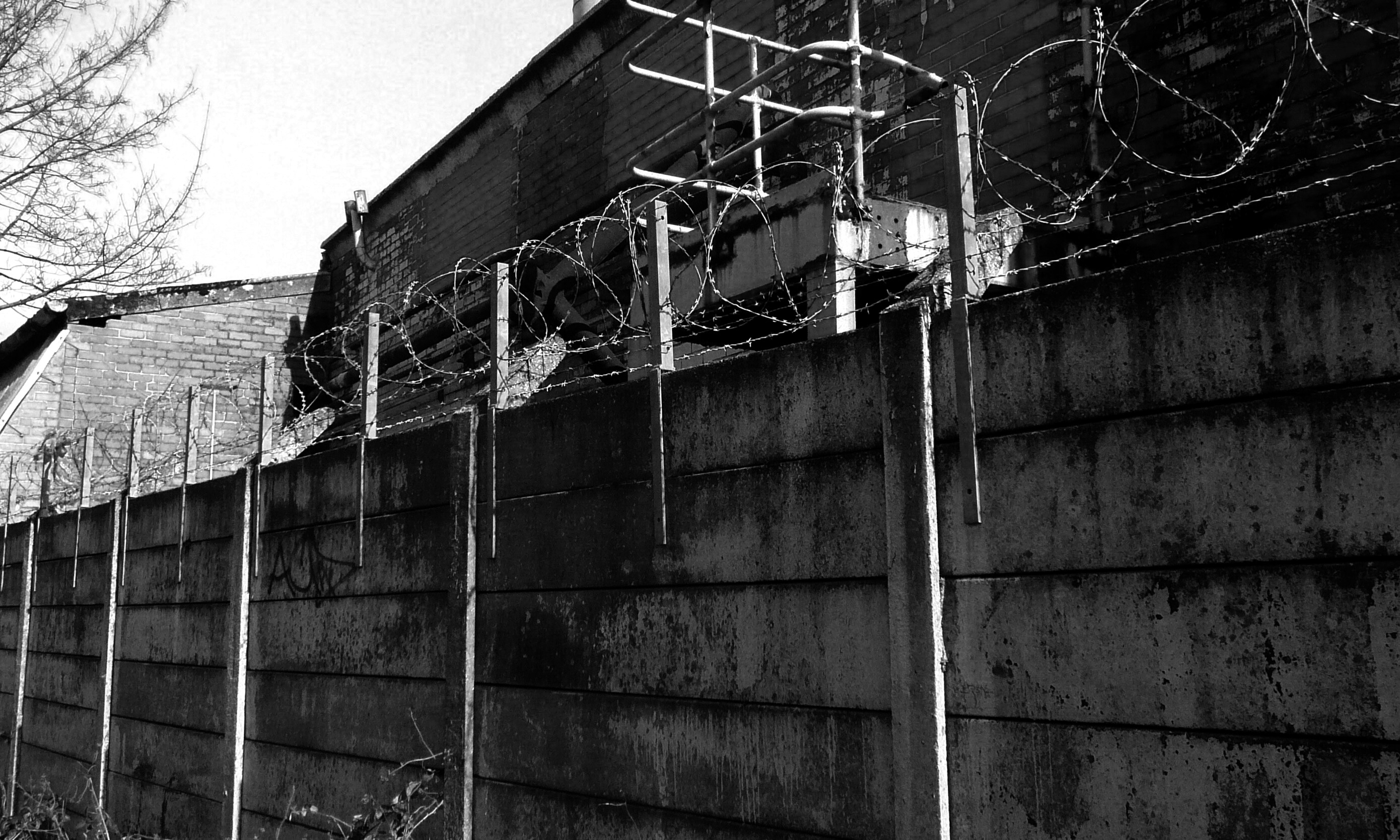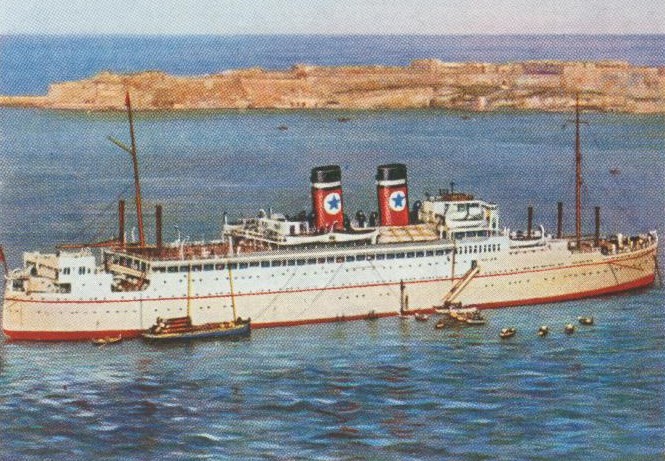Warth Mills Internment Camp.
‹ Return to Berlin

Warth Mills Internment Camp, Bury.
Photographed at dawn, these are the original cotton mill buildings in the middle of what is now Warth Business Park on Radcliffe Road in Bury.
Warth Mills as a Prisoner of War camp is described here.
_________________________________________________________________________
When I was at school (Derby High School) in Bury there was a paint factory next door called MacPhersons. We knew it used to be a Prisoner of War camp and our cross country running route took us past the old concrete walls and barbed wire posts which are still there today (see photo below).
Researching the history of Warth Mills POW Camp has revealed a disturbing side to Britain’s wartime history though, one which most history books don’t mention; the treatment of many thousands of ‘enemy’ civilians, most of them Jewish refugees who had fled persecution in Germany.
There were a handful of internee camps around the country but the one at Warth Mills in Bury was by all accounts the most notorious of all. That is not to say Jewish refugees were murdered or forced into slave labour at Warth Mills but their treatment is still shameful occurring at a time we nationally consider to be our finest hour (1940, Dunkirk and the Battle of Britain etc).
Initially when war was declared in September 1939 all Germans and Italians in Britain (some 80,000 of them) underwent a process where they were categorised according to risk to national security.
However, once Germany had occupied France and the invasion of Britain seemed imminent, Churchill decided to “collar the lot” and every German and Italian, regardless of their ethnicity or reason for being in the UK was imprisoned. While that seems understandable – and graciously a great many refugees did not hold that against the authorities even though they were split up from their families and denied letters or radio and newspapers – the treatment of them, particularly at Bury, was indefensible. Jewish people, many of whom had been in concentration camps, were locked up with other Germans who were Nazis. Fights and suicides were common.
Conditions were so bad at Warth that the place was condemned as unfit for habitation by the Red Cross. Inmates had no beds, just wooden boards or slept on the floor with little or no bedding, no heating and no electricity. 2,000 people were at Warth in 1940 with reportedly just 18 water taps and only one bathtub. There were no toilets either just some buckets in the yard.
The place was rat infested, the food scarce and vile and prisoners had to eat standing up because there were no tables. The roof leaked rain, the inmates were denied medicine and medical treatment and received no information about their families.
To add to the internees’ misery, the guards stole from them and the Commandant, a Major A J Braybrook with the Territorial Army was later convicted (July 25 1941) of stealing money and property to the value of between fifty and sixty thousand pounds from the Jewish internees.
Churchill decided to further reduce the perceived risk posed by these people by shipping them off to camps in Canada and Australia. 1,216 internees, many of whom would have been at Bury, boarded the SS Arandora Star on July 1st 1940 which was not escorted by destroyers for the Atlantic crossing. It was sunk the day after by a U-boat off the coast of Ireland. 630 internees drowned.
The sinking created a big change in public opinion and the practice of locking up all civilians or shipping them overseas gradually ceased. By early 1941 the majority had been released.
Warth Mills ceased to be an internment camp and instead became a Prisoner of War camp after being ‘reconditioned’.
Derby High School’s cross country running route took us past these walls and barbed wire posts. Although the wire is new, I think the concrete wall and posts are from the original camp.

The SS Arandora Star

Image from wikipedia commons
en.wikipedia.org/wiki/SS_Arandora_Star
Model of the Arandora Star at Liverpool Maritime Museum

Some sources
Warth Mill Remembered Kenneth F Sheridan, Association of Jewish Refugees magazine (page 3), June 1990. This short first-hand account by a former internee at Warth is well worth reading.
www.ajr.org.uk/journalpdf/1990_june.pdf
Court of Inquiry Report into the manner in which Major Braybrook, Commandant at Warth, was investigated.
webcache.googleusercontent.com/search?q=cache:n54kK4lTvAE…
Bury and the Second World War, Ken Inman and Michael H Helm, 1995.
Remembering Refugees Then and Now, Tony Kushner, 2006
33 comments on “Warth Mills Internment Camp.”
Leave a Reply to crusader752 Cancel reply
Image Information
-
Full Size: 3008×2000px
Aperture: f/5.6
Focal Length: 122mm
ISO: 200
Shutter: 1/200 sec
Camera: NIKON D40



~sad bu t interesting story~
Makes for very unsavoury reading Ian. Shameful indeed…..
This is first class reporting Ian – you should be working for TV..Fantastic stuff I’ve learned from your stream..
Excellent well captured and very informative..
Yeah, shameful seems appropriate.
I had no idea about conditions in these internee camps mate, I suppose we like to think that "we" treated prisoners well and the horrors were the work of others. There were POW camps around here although I understand the conditions were in no way like those Warth.
Another one of your posts that has educated me, thank you.
Superb commentary Ian!
An absolute shameful way of treating people.
I still know older folk in Rochdale who whinge about Gracie Fields leaving Rochdale when she was married to Monty Banks (an Italian citizen)
From Wiki: However, because Banks remained an Italian citizen and would have been interned in the United Kingdom, she was forced to leave Britain for North America during the war, at the instruction of Winston Churchill, who told her to "Make American Dollars, not British Pounds," which she did, in aid of the Navy League and the Spitfire Fund. She and Banks moved to their home in Santa Monica, California. She did, occasionally, return to Britain, to show she was not, indeed, a traitor, performing in factories and army camps around the country. After their initial argument, Parliament offered her an official apology.
A shocking account of our hidden history. A very informative lesson from you, as always Ian.
very interesting story ian , how many more was like this , makes you wonder
[http://www.flickr.com/photos/61126360@N07] [http://www.flickr.com/photos/southseadave] [http://www.flickr.com/photos/highy] [http://www.flickr.com/photos/nondesigner] [http://www.flickr.com/photos/25305713@N04] [http://www.flickr.com/photos/29288836@N00] [http://www.flickr.com/photos/longsidepies] [http://www.flickr.com/photos/mick_cooke_wildlife]
Thanks all. Glad you find it interesting. I am always surprised people read all this stuff I put up on Flickr. If nothing else it is a record on the internet which wasn’t there before, for as long as Yahoo continues to exist at least…
Rob that’s interesting about Gracie Fields, I didn’t know that about her. See her in a new light now (whenever I think of Gracie Fields in my mind’s eye I see Lisa Stansfield…)
I just had a look at wikipedia about Gracie Fields. Poor that she was treated that way and she lived up to her name by having the good grace to continue to remain loyal to Britain.
Mick by all accounts Bury was uniquely bad. Conditions on the Isle of Man were much better… But they were still interned.
[http://www.flickr.com/photos/maycontaintracesofnuts] Fascinating story Ian, shocking the way these people were treated, not this countrys finest hour sadly.
Amazing story Ian … and in near past too. I guess there were a few of these type of places around but the signs and memories are being erased now
great shot, that dawn shot – most beautiful light and adds a sense of peace, unlike the history of the place itself. great to see the texture in the fence scene, adds that little extra .. interesting place for a cross-country run [funny what we grow up with that seems normal].
first time i read of ‘locals’ / migrants being interred within their own / adopted country was of David Suzuki [scientist / environmentalist] being a Japanese child in the US [or Canada] during WWII. not sure about the conditions though, but what you’ve mentioned is terrible. they were conflicting times to say the very least, but to one day be a citizen and the next, a prisoner and treated probably worse than actual prisoners of the day, would be quite heartbreaking.
more ticks into your sainthood report for this one, great to raise this awareness and tell the tale of those that get forgotten. it is another way of remembering those that suffered, by no choice of their own.
Hidden local history indeed – I never had a clue about these internment camps especially one so local. Great commentary Ian.
It is interesting how dedicated and detailed you are in recording this era of British history. The war was such a major event in human history. Like a modern day crusades. Nice work.
[http://www.flickr.com/photos/davel59] [http://www.flickr.com/photos/cameragirl6] [http://www.flickr.com/photos/51809269@N08] [http://www.flickr.com/photos/cachelog] [http://www.flickr.com/photos/angwickham] Thanks for your comments everyone, they are much appreciated.
[http://www.flickr.com/photos/maycontaintracesofnuts]
Hi Ian , We are back .
Did you know there was one in Oldham too called Glen Mill . A german prisoner was shot by accident (sort of) there , on the road outside the prison . It seems there is a circular feature something akin to a guard post /tower just off the road that is still extant . Nothing else remains though. Itw as in this months Britain at War .
I remember you mentioning the Bury one , glad tosee you have got around to covering it . Excellent work !
Blimey, Ian… I had no idea… Not just of the camp’s existence but of the treatment. While there was the occasional skirmish within most often the Tule Lake, CA site, the only killings were by the US Army guards. Even so, I believe it was less than six.
In addition, while conditions were, shall we say, poor at the very beginning, I’m sure it could not be as bad as you described at Warth Mills. My female cousin said when she first got to camp here, the ladies latrine (public) was lust a concrete slab with holes every so many inches apart. No walls. No plumbing.
You did a TREMENDOUS, DETAILED job researching this "buried" topic (sorry for the pun). I also believe a nickname/descriptive compliment is in order here: "Patently Ian".
It is something civilized nations will always try to hide or deny – just like Japan ignores the allegations of "pleasure women".
Yes, as you say, not something that it generally publicised. Thanks for doing that though, and with great detail and a superb photo to boot
I learn so much from your photos – I knew people were interned but always assumed they were in much better conditions.
Apologies for the late replies.
[http://www.flickr.com/photos/pasujoba44]
good to see you back mate, catch up tomorrow.
[http://www.flickr.com/photos/p47koji] Thank you Koji, I very much appreciate your views on this given the experiences of your father in the camps for Japanese internees in the US during the war. I think the internees experience generally wasn’t that bad, it was just that at Warth Mills the conditions were inhuman. You are right too, by the way. National history does photoshop out inconvenient history. As well in Japan I understand schoolkids learn nothing of the treatment of the Chinese before and during the war? And British schoolkids never read about the Bengal famine and the neglect / failure of the British to prevent the deaths of millions in 1943.
[http://www.flickr.com/photos/stopherjones] [http://www.flickr.com/photos/stickotopia] Thanks very much guys, that is the sort of feedback that keeps me doing this!
[http://www.flickr.com/photos/p47koji] "this "buried" topic (sorry for the pun) – well done!
"I also believe a nickname/descriptive compliment is in order here: "Patently Ian". – Hear Hear.
A belated follow-up: one of the British soldiers guarding the internees on the Arandora Star was former Bury Grammar School pupil Tom Cartman. One of the first volunteers for the Manchester Pals in 1914, he won the MC at the Battle of Arras in 1917 and ended the war as a Captain. He re-enlisted in 1939 and as a Lieutenant was posted to the Arandora Star along with a number of other WWI veterans. 39 of the British guards, including Tom Cartman were lost in the disaster. In 2012 his Great War scrapbook was miraculously recovered from a skip in Blackpool:
http://www.bgsalumni.com/the-great-war-scrapbook-of-captain-thomas-cartman/
Interesting detail to add, thanks for the link Mark.
My grandfather who was at the time running a business within the Italian Community in South Wales was interned here leaving his wife at home with 6 month old twins. I am sad to learn of the conditions but also glad to know. Can this camp be visited? My grandfather lost his life on the Arandora Star.
Hi Janina, it is sad to read of your grandfather’s internment at Bury and his death on the Arandora Star.
The site is now managed by Warth Business Centre – there are a number of businesses here. I know there is a security guard and I photographed the old building from outside the grounds, didn’t ask if I could go in. But if you contacted the company and explained how you’d like to see the place, I doubt there would be a problem. Here is link to Warth Business Centre.
http://warthbusinesscentre.com/
Best wishes,
Ian
I am part of a lottery funded project researching warth mill and its internees especially the Italians. If you know of other people who had relatives there and would be willing to talk about their experiences we would be really grateful.
Hello, I believe my grandfather Antonio De Angeli was there. my grandfather was Italian born, WWI infantryman who came to London and worked in hotel restaurants (Park lane Hotel was one). He was “collared” (he was married to an Englishwoman and had 2 sons at that time) and I believe he was sent to Bury and then to the Arandora Star. If he was at worth mills/Bury his Bury id may have been 59282. On an arandora star FB page, there is a file listing A De Angelis which may have been him. He was eventually sent to Palace Camp at IOM and then Metropole. he was at the IOM till late 1944. I have his birthdate and place of birth and his alien card photo. I am trying to find more info about the A. DeAngelis from Bury to try to confirm if it was him. any leads appreciated. is here any documentation available about the Bury/Warth Mills interns? where I might find more info about “A De Angelis” ? thank you .
If this site is still in use you might be interested to know I have found a German prisoner of war diary
The person in question was held at camp 12 in bury & Belfast
The diary is a wartime log issued by the ymca in Geneva
Within the diary are hand drawn pictures of the camp as well as pictures of home & many notes of life & music written within the camp
Within book is also a programme for a concert at 32 German working camp in Shepherd’s Bush
It’s a very interesting insight into the life of a pow
If anyone is interested I could publish parts of the diary
I have attempted to find info on the prisoner & any help would be great
I am sure the prisoner made a life in England after his release
Name Erich Schneider
I also have a photo of Erich in full battle dress
Hi Dave, sorry for the late reply, just seen your post. Sounds like a terrific find you have there. Something similar was discovered and put on the page about Glen Mill PoW camp at Oldham on this site. If you would like to scan or photograph some (or all) of the pages I would be happy to add them here, create a seperate page for them.
Ian
I am part of a project researching Warth mill internment camp which is being funded by theLottery
I would welcome any information and contacts.
Hello Margaret
We have spoken at U3a cottonopolis
I am now fascinated by this project and so is the Manchester Jewish Genealogy Society whose committee i have recently joined. We would like to track the histories of Jews interned there. Please contact me on anthonyscottnorman@btinternet.com or 0161 637 4574 better still , ps have agreed with them to check out records at PRO Kew. Has anyone done that given Home Office responsibilty.? Regards anthony
Book out on the whole shameful episode in our town Of Bury ,re Warth Mill,along with the much better treatment whilst interned Isle of Man.